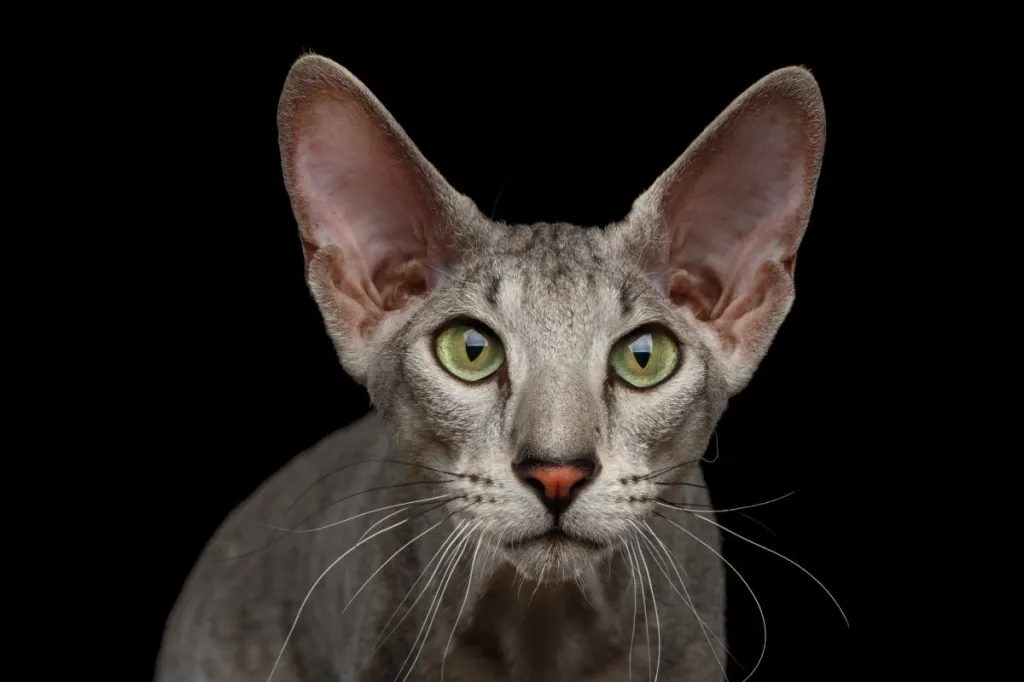Picture a feline that’s a stunning blend of elegance and exotic charm, and you’ve got the Peterbald, a breed that’s turning heads and stealing hearts around the globe. The Peterbald is a mixed breed cat–a cross between the Donskoy and Oriental Shorthair breeds.
Hailing from Russia, these cats are like the James Bonds of the feline world – sleek, sophisticated, and oh-so-stylish. What sets them apart? Well, for starters, their fur (or lack thereof). Peterbalds come in various coat types, from completely bald to velvety fuzz, making each truly unique. In terms of temperament, Peterbalds are known for being social butterflies, forming strong bonds with their human counterparts. Playful, intelligent, and always up for a cuddle, these cats know how to bring joy and excitement to any household.
When considering a Peterbald, it’s advisable to prioritize adopting from rescue organizations or shelters to provide a loving home to a cat in need. However, if you decide to purchase, it’s crucial to choose a reputable breeder. Conduct thorough research to ensure that the breeder follows ethical practices and prioritizes the well-being of their cats. Reputable Peterbald breeders prioritize the health and temperament of their cats, conduct necessary health screenings, and provide a nurturing environment for the kitties. This active approach ensures that you bring home a healthy and happy kitty while discouraging unethical breeding practices.
Quick Facts
- Origin: St. Petersburg, Russia
- Size: Medium
- Breed Group: Shorthair (multiple coat variations)
- Lifespan: 12-15 years
- Coat: Can be bald, flocked, velour, brush, or straight, with various colors and patterns
- Temperament: Intelligent, playful, affectionate, social, outgoing, curious
- Exercise Needs: Moderate
- Training: Easy to train
- Grooming: Varies depending on coat type
- Health: Generally healthy, but prone to some genetic conditions
- Distinguishing Features: Slender and muscular body, almond-shaped eyes, large pointed ears, long whip-like tail, webbed feet, oval paws
- A Peterbald’s coat can change throughout its lifetime, meaning it can lose its fur or even grow a coat when previously bald.
- Due to their baldness, Peterbalds have a higher than average metabolism, and will require more meals.
- The gene for hairlessness is dominant in Peterbald cats. If they are bred to another cat, hairless kittens will be in the litter. Any Peterbald with a “straight coat” does not carry the hairless gene.
Peterbald Pictures
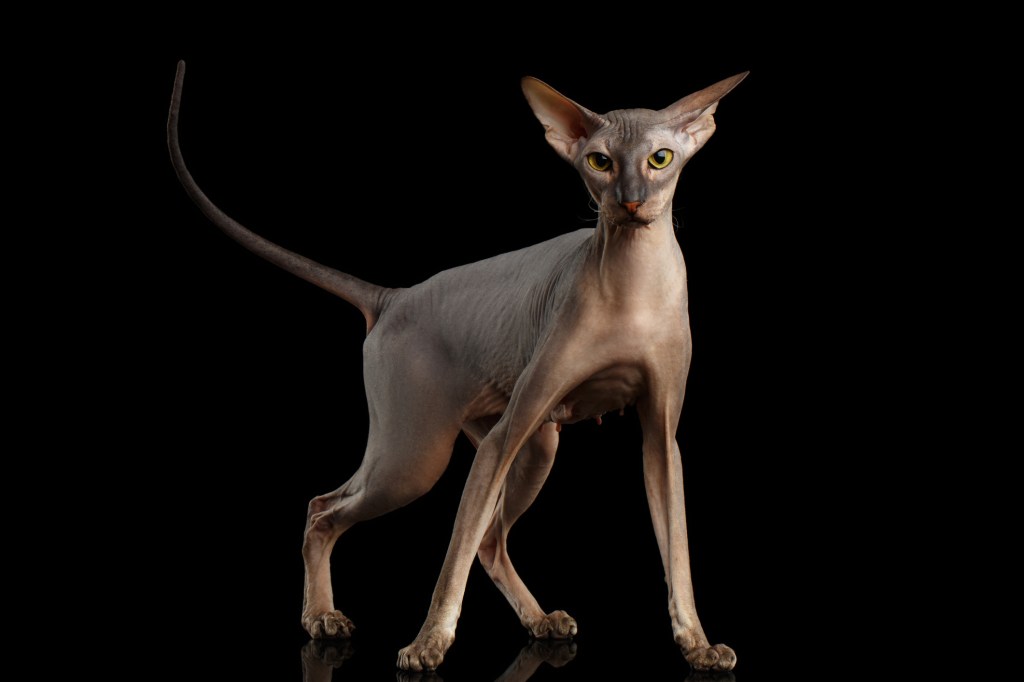
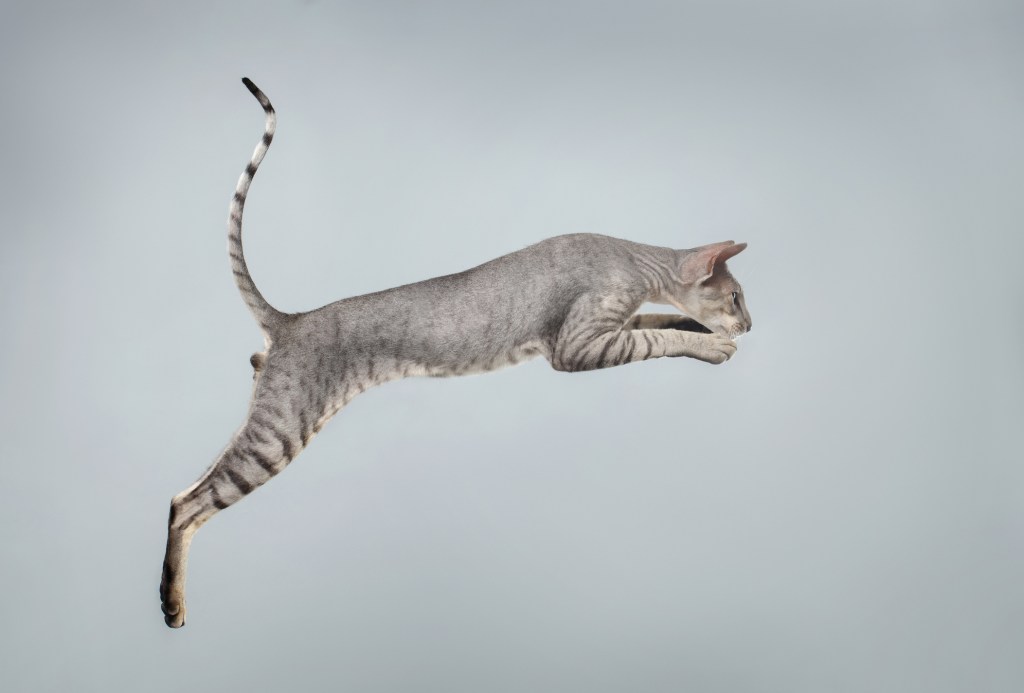
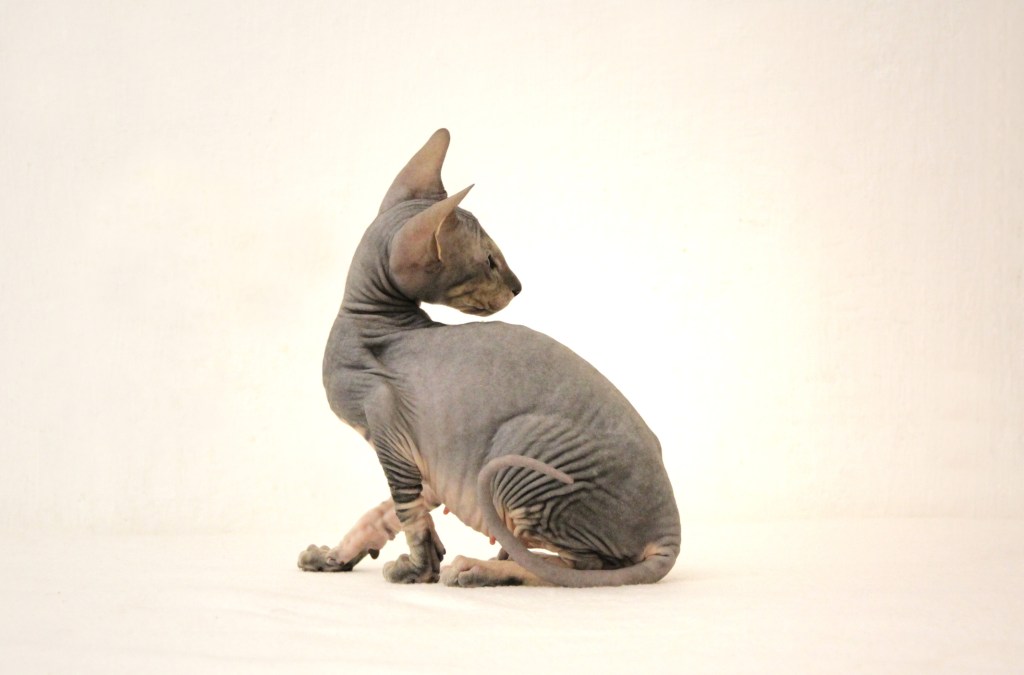
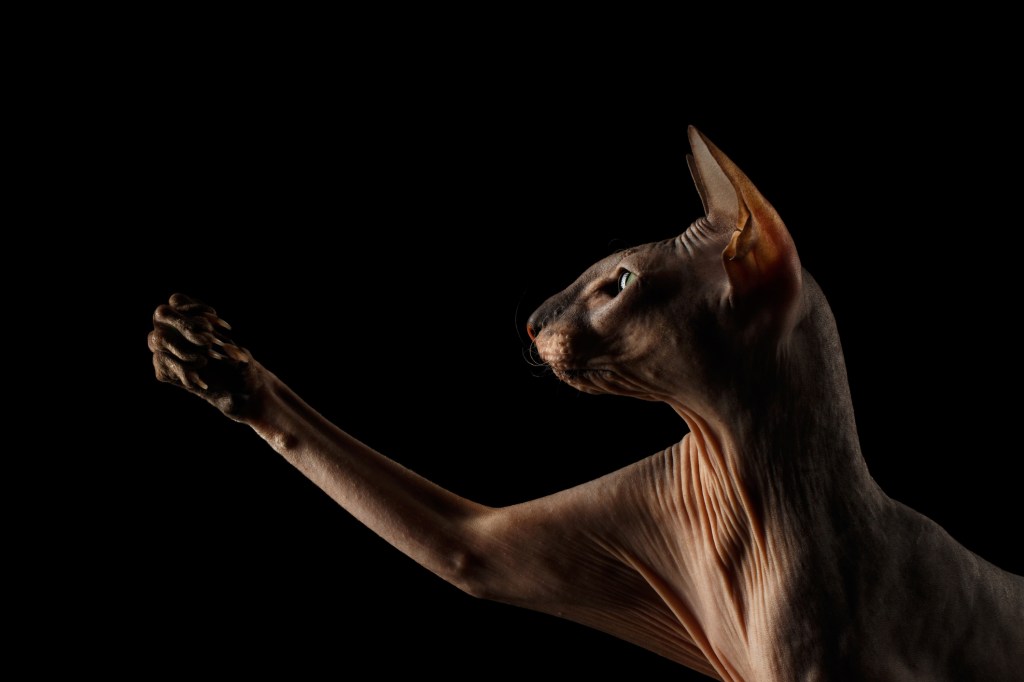
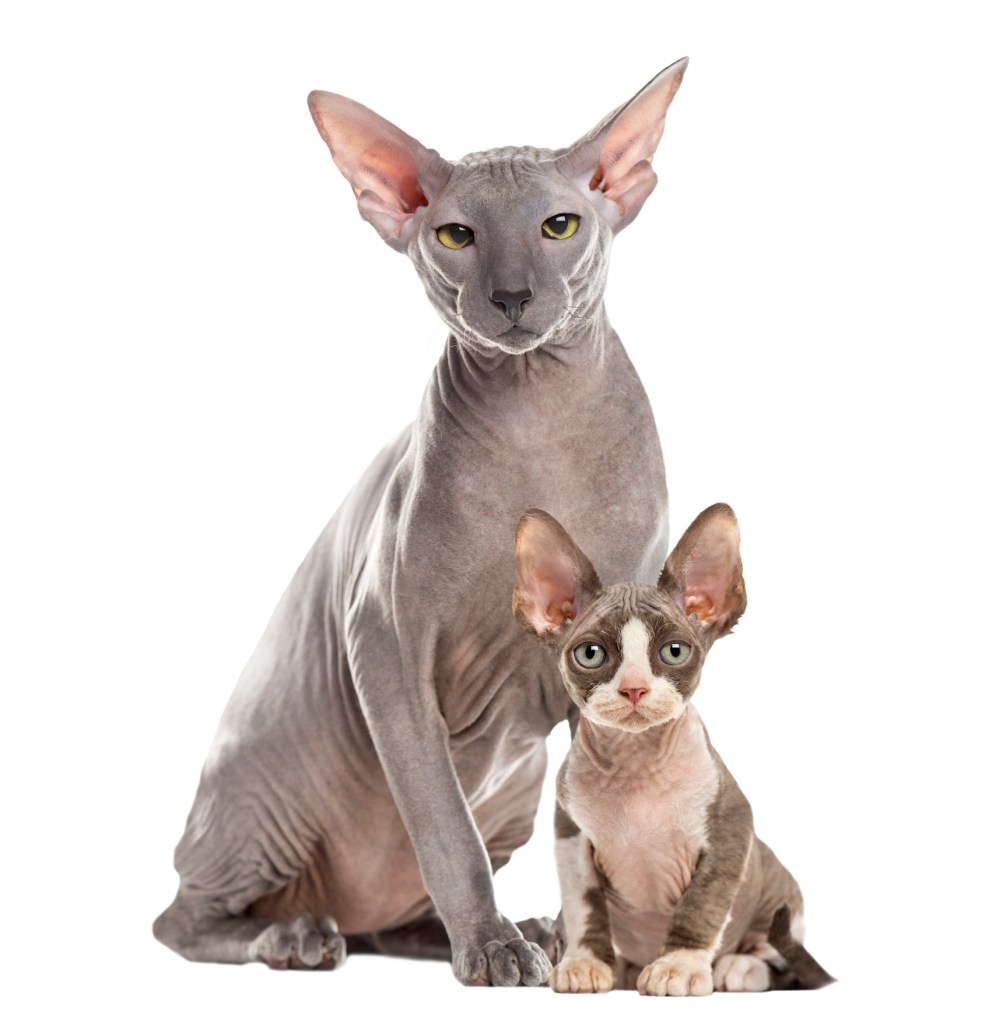
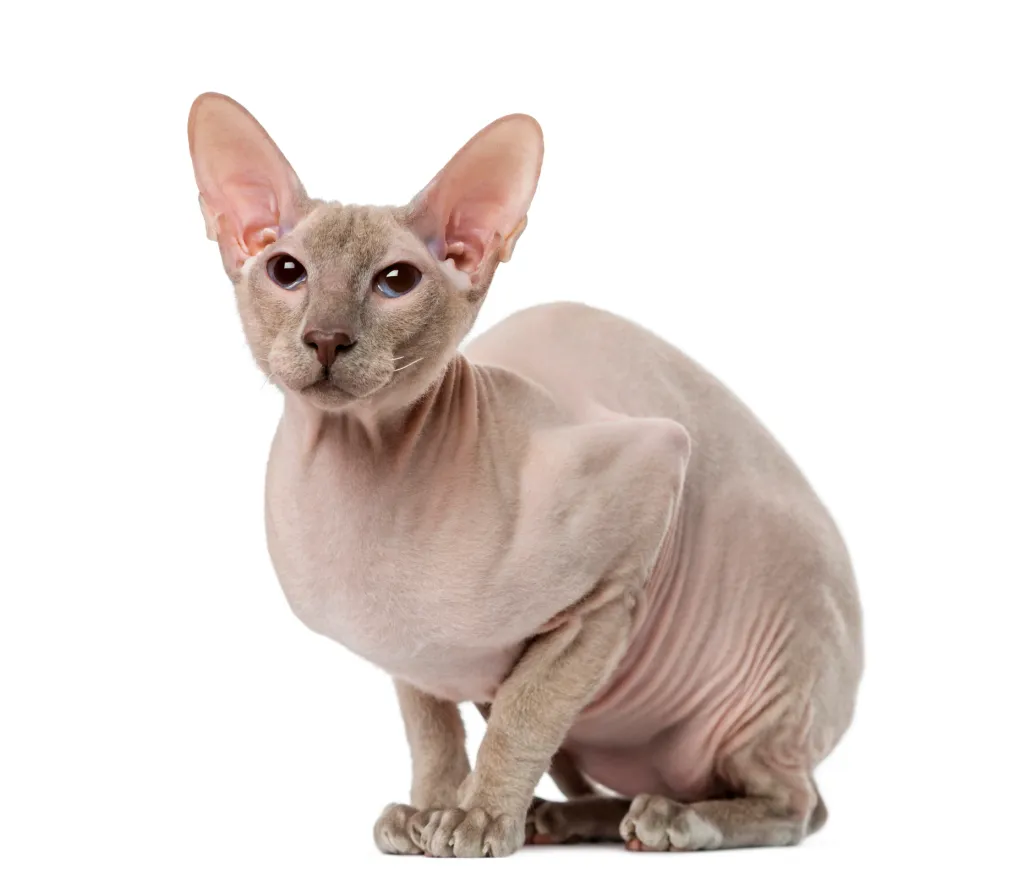
-
Affectionate with Family
Some cat breeds are typically independent and aloof, even if they’ve been raised by the same person since kittenhood; others bond closely to one person and are indifferent to everyone else; and some shower the whole family with affection. Breed isn’t the only factor that goes into affection levels; cats who were raised inside a home with people around feel more comfortable with humans and bond more easily.

See Cats Less Affectionate with Family -
Amount of Shedding
If you’re going to share your home with a cat, you’ll need to deal with some level of cat hair on your clothes and in your house. However, shedding does vary among the breeds. If you’re a neatnik, you’ll need to either pick a low-shedding breed or relax your standards. This furniture cover can make it easier to clean up cat hair and keep it off your sofa!
-
General Health
Due to poor breeding practices, some breeds are prone to certain genetic health problems. This doesn’t mean that every cat of that breed will develop those diseases; it just means that they’re at an increased risk. If you’re looking only for purebred cats or kittens, it’s a good idea to find out which genetic illnesses are common to the breed you’re interested in.
-
Potential for Playfulness
Some cats are perpetual kittens—full of energy and mischief—while others are more serious and sedate. Although a playful kitten sounds endearing, consider how many games of chase the mouse-toy you want to play each day, and whether you have kids or other animals who can stand in as playmates. A classic wand cat toy like this one is perfect for playful felines!
-
Tendency to Vocalize
Some breeds sound off more often than others with meows, yowls, and chattering. When choosing a breed, think about how the cat vocalizes and how often. If constant “conversation” drives you crazy, consider a kitty less likely to chat.
-
Kid-Friendly
Being tolerant of children, sturdy enough to handle the heavy-handed pets and hugs they can dish out, and having a nonchalant attitude toward running, screaming youngsters are all traits that make a kid-friendly cat. Our ratings are generalizations, and they’re not a guarantee of how any breed or individual cat will behave; cats from any breed can be good with children based on their past experiences and personality.
-
Friendly Toward Strangers
Stranger-friendly cats will greet guests with a curious glance or a playful approach; others are shy or indifferent, perhaps even hiding under furniture or skedaddling to another room. However, no matter what the breed, a cat who was exposed to lots of different types, ages, sizes, and shapes of people as a kitten will respond better to strangers as an adult.
-
Easy to Groom
Some breeds require very little in the way of grooming; others require regular brushing to stay clean and healthy. Consider whether you have the time and patience for a cat who needs daily brushing. You should definitely pick up this awesome de-shedding tool for cats of any hair length!
-
Intelligence
Some cat breeds are reputed to be smarter than others. But all cats, if deprived the mental stimulation they need, will make their own busy work. Interactive cat toys are a good way to give a cat a brain workout and keep them out of mischief. This scratcher cat toy can keep your smart kitty busy even when you’re not home!
-
Pet Friendly
Friendliness toward other household animals and friendliness toward humans are two completely different things. Some cats are more likely than others to be accepting of other pets in the home.
Peterbald History
The story of the Peterbald dates back to 1993 when the Donskoy was bred with the Oriental Shorthair. A new hairless cat emerged, and it was named the Peterbald due to its popularity in the city of Saint Petersburg.
Over the years, certain Peterbald cats have been born with a very short coat, so the breed isn’t technically always hairless.
The Peterbald was officially accepted for championship competition by the International Cat Association (TICA) in 2005.
These days, you may find Peterbalds in shelters or in the care of rescue groups. So make sure to consider adoption if you decide that this is the breed for you!
Peterbald Size
The Peterbald is a medium-sized cat. As is always the case, exact size standards might vary.
Most Peterbalds weigh in at six to ten pounds. Some can be smaller or larger than average.
Peterbald Personality
First up, you’ll instantly notice just how much this breed loves humans. Peterbalds very quickly form super strong bonds with the humans in their lives and will often follow them around from room to room, much in the fashion of a dog.
This loyal streak means that the Peterbald also makes a great cat for households with young children. But make sure that you can spend enough time with your Peterbald on a day-to-day basis, as this breed doesn’t enjoy being left alone for long periods of the day.
While the Peterbald is often hailed as a very affectionate and loving feline, these cats also have a strong athletic streak and will very much enjoy extended play sessions. In many cases, the Peterbald is also said to be a very vocal cat–so be prepared to engage in cat talk conversations with the breed!
Peterbald Health
Peterbalds are generally considered to be healthy cats; although, they can be predisposed to the same conditions that the Donskoy and Oriental Shorthair breeds face. As always, it’s important to schedule regular wellness visits with your cat’s vet. There aren’t any breed-specific health problems associated with the Peterbald, but always keep an eye out for signs that your cat might be in distress or pain.
- Skin Sensitivity: Due to their unique coat types, some Peterbalds with little to no hair may be more sensitive to sun exposure. It’s advisable to provide them with shade and protection from direct sunlight.
Peterbald Care
As with all cats, it’s important to keep up your Peterbald’s regular veterinary checkups to detect any health concerns early. Your vet can help you develop a care routine that will keep your cat healthy.
Beyond scheduling yearly wellness visits with your vet, make sure that you pick up a scratching post for your Peterbald cat’s living environment. This can help promote healthy scratching and keep the cat’s nails in good condition.
The Peterbald usually has larger-than-normal ears, and they should be examined regularly for signs of dirt building up or possible infection.
Talk to your vet about starting a regular teeth brushing regime that will suit your Peterbald. Your vet can advise you about specific brands of toothpaste and brushing techniques.
Finally, because the Peterbald is a cat with a decent amount of energy, it’s recommended that you add at least one cat tree to your home environment.
Peterbald Coat Color And Grooming
The Peterbald is usually hairless, although sometimes the breed will posses a very short and almost fuzzy layer of coat. The Peterbald comes in a wide range of colors.
When it comes to grooming, a totally hairless Peterbald will require bathing at least once a week. This is to get rid of any oils that accumulate on the skin. Also, consult with your vet about using feline-friendly sunscreen, especially if the cat has access to the outdoors.
In terms of climate, most Peterbald cats prefer warmer weather rather than cold environments. It’s best to keep the breed indoors so that it can find warm and cosy spots to lounge around in.
Children And Other Pets
The Peterbald is a great fit for families with young children. Just make sure that early socialization takes place and boundaries are properly set on both sides. Supervise early interactions between kids and cats.
When it comes to other household pets, the friendly and outgoing Peterbald usually fares well with most other domestic animals. But always make sure to supervise early interactions between the new cat and existing pets, too. Sometimes these relationships are very much dependent on the individuals pets’ personalities.
Ultimately, early socialization really pays off with this breed. Make sure to reward your Peterbald for good behavior when you bring them home to your family!
Peterbald Rescue Groups
It may be hard to find a breed specific rescue for Peterbald cats because they are a mixed breed. However, you may want to try breed specific rescues that care for Donskoy or Oriental Shorthair cats, as they sometimes care for breed mixes, too. You may also try shelters and rescues that cater to all types of cats, including Peterbalds, as well as your local shelter. Here are some nonprofit rescues you can try:
More Info For You
If you’re also looking for a dog, check out DogTime’s dog breed page!
